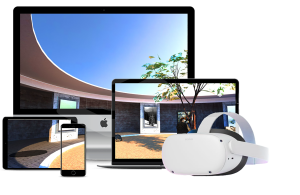VDI (Virtual Desktop Infrastructure)
All of the individual tools in the Hyperspace Metaverse Platform are designed to run independently across devices and platforms. Content is 100% HTML5 using ‘responsive design’ targeted at mobile, tablet, desktop and VR/AR. Viewing an experience is equivalent to loading a web page. All assets are static and don’t require streaming. The Hyperspace Metaverse Platform requires WebGL capable browsers described individually below that currently account for over 98% of browsers in use, as described here; http://caniuse.com/#feat=webgl
The following is a summary of the minimum requirement for the most popular 5 operating systems with the specification and browser requirement to run the Hyperspace Metaverse Platform and details of the graphic and bandwidth requirements.
Windows
- 1.4GHz Intel® Pentium® 4 or faster processor (or equivalent) for Microsoft® Windows 7, Windows 8 or Windows 8.1
- Windows 10, Windows 11, 8.1 (32-bit/64-bit), 8.0 (32-bit/64-bit), Windows 7 (32-bit/64-bit)
- 512MB of RAM (1GB recommended) for Windows 7 or Windows 8
- Google Chrome; Microsoft Internet Explorer 11 or later; Microsoft Edge; Mozilla Firefox;
Mac OS
- 1.83GHz Intel Core™ Duo or faster processor
- 512MB of RAM (1GB recommended)
- Mac OS X 10.8, 10.9, 10.10, 10.11, 10.12, 10.13, 10.14, 10.15, 11, 12
- Google Chrome, Mozilla Firefox; Apple Safari;
Linux
- Ubuntu 14.04; Red Hat Enterprise Linux 6; OpenSuSE 13.1
- Google Chrome; Mozilla Firefox
Apple iOS
- Apple supported devices: iPhone 6S, iPhone 6, iPhone 5S, iPhone 5, iPhone 4S, iPad with Retina display, iPad 3, iPad 2, iPad mini, and iPod touch (5th generation)
- Apple supported OS versions summary: iOS 8 and higher; iPadOS
- Apple Safari; Google Chrome
Android
- Android supported OS versions summary: 4 and higher
- Google Chrome; Android 5 and above Native Chromium; Mozilla Firefox; Microsoft Edge;
Chrome OS
- Google Chrome on ChromeOS devices is supported.
VDI (Virtual Desktop Infrastructure)
Although some clients are able to run 3d environments on VDI’s, it is not recommended due to performance limitations on standard enterprise VDI’s.
VDI’s specifically designed for 3d performance may be suitable but no testing or confirmation can be supplied by Hyperspace.
Read more about GPU accelerated VDI’s here https://learn.microsoft.com/en-us/azure/virtual-machines/sizes-gpu
Graphics Drivers
Generally WebGL is supported on all modern video graphics chipsets but may be disabled on graphics drivers built in and before 2008 along with some exceptions listed here https://www.khronos.org/webgl/wiki/BlacklistsAndWhitelists
Content Bandwidth
All content is HTML; content, avatars and 3D environments vary in size based on the experience. Content loads progressively in the same manner as websites, and can be split into pages/places. Recommend 3G or Cable/DSL.
Avatars are made up of static mesh files and textures again loaded in the same way as normal website requests. Multiuser avatar data is lightweight only transferring location information and triggers for gestures.
The Hyperspace Metaverse Platform uses native text to speech built into browsers so requires zero bandwidth and is able to fall back to online audio services as required to deliver online text to speech as mp3 audio.
Conferencing Bandwidth
Multiuser voice and video communication bandwidth falls into two categories
1) Meetings https://www.twilio.com/docs/voice/sdks/network-connectivity-requirements#network-bandwidth-requirements
If you are using a 3rd party conferencing solution rather than the solution bundled with the 3D Platform, you will need to check the 3rd party’s specific requirements.
Multiuser text chat is low bandwidth.
Regions
China
Meetings
The platform uses Twilio for voice and video meetings. There is no technical limitation that should prevent Twilio Programmable Video from working in China. However, Twilio does not operate data centers in China.
If you are experiencing connectivity problems with your Video calls in China, then you should contact support about configuration to connect through Asia-Pacific data centers based in Singapore, Japan or India.
Depending on the user’s location and the network topology chosen, users may experience some connectivity issues.
Webinars
The platform uses Vonage for webinars. Connectivity and media quality can depend on a number of factors, including the quality of the last mile, the traffic load on the ISP, and the performance of the data center.
For Webinars we recommend you test performance with China based users.
Contact support for China Relay pricing options.

